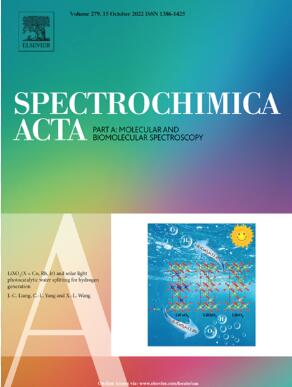A new SERS substrate: Ag-nanoparticles immobilized on glass for rapid scale inhibitor determination − Theoretical and experimental approach
IF 4.3
2区 化学
Q1 SPECTROSCOPY
Spectrochimica Acta Part A: Molecular and Biomolecular Spectroscopy
Pub Date : 2025-05-21
DOI:10.1016/j.saa.2025.126442
引用次数: 0
Abstract
This study introduces an innovative approach for the rapid detection of scale inhibitors, with a focus on aminotris-(methylene phosphonic acid) (ATMP), a compound critical to petroleum industry operations. The traditionally employed technique of inductively coupled plasma optical emission spectrometry (ICP OES) requires expensive equipment and skilled personnel and is labor-intensive and time-consuming. In contrast, we propose using silver nanoparticles (AgNPs) immobilized on a glass substrate to enhance Raman spectroscopy through the Surface-Enhanced Raman Scattering (SERS) effect. Characterization of the AgNPs via Dynamic Light Scattering (DLS) revealed an average hydrodynamic diameter of 43 nm. Additionally, a computational analysis of the interactions between the AgNPs and the scale inhibitor was performed, contributing to a deeper understanding of the binding mechanisms and interactions at the molecular level. The methodology enabled the detection of ATMP at concentrations around 10−4 M, demonstrating its effectiveness in identifying scale inhibitors under field-applicable conditions. A significant increase in SERS intensity was observed, with an amplification of approximately sevenfold when employing four layers of AgNPs compared to a single layer. The results indicate that the proposed approach is efficient, reliable, and cost-effective, positioning itself as a promising alternative to conventional techniques. It has potential implications for continuously monitoring inhibitors in drilling and production operations within the petroleum industry.
一种新的SERS底物:固定在玻璃上的银纳米颗粒用于快速测定阻垢剂-理论和实验方法
本研究介绍了一种快速检测阻垢剂的创新方法,重点是氨基膦酸(ATMP),一种对石油工业作业至关重要的化合物。传统的电感耦合等离子体发射光谱(ICP OES)技术需要昂贵的设备和熟练的人员,并且劳动强度大,耗时长。相反,我们提出将银纳米颗粒(AgNPs)固定在玻璃衬底上,通过表面增强拉曼散射(SERS)效应来增强拉曼光谱。动态光散射(DLS)表征AgNPs的平均水动力直径为43 nm。此外,对AgNPs和阻垢剂之间的相互作用进行了计算分析,有助于在分子水平上更深入地了解结合机制和相互作用。该方法能够检测到浓度在10 - 4 M左右的ATMP,证明了其在现场适用条件下识别阻垢剂的有效性。观察到SERS强度显著增加,当使用四层AgNPs时,与单层相比,其放大约为七倍。结果表明,所提出的方法是高效、可靠和经济的,将其定位为传统技术的一个有前途的替代方案。它对石油工业中钻井和生产作业中抑制剂的持续监测具有潜在的意义。
本文章由计算机程序翻译,如有差异,请以英文原文为准。
求助全文
约1分钟内获得全文
求助全文
来源期刊
CiteScore
8.40
自引率
11.40%
发文量
1364
审稿时长
40 days
期刊介绍:
Spectrochimica Acta, Part A: Molecular and Biomolecular Spectroscopy (SAA) is an interdisciplinary journal which spans from basic to applied aspects of optical spectroscopy in chemistry, medicine, biology, and materials science.
The journal publishes original scientific papers that feature high-quality spectroscopic data and analysis. From the broad range of optical spectroscopies, the emphasis is on electronic, vibrational or rotational spectra of molecules, rather than on spectroscopy based on magnetic moments.
Criteria for publication in SAA are novelty, uniqueness, and outstanding quality. Routine applications of spectroscopic techniques and computational methods are not appropriate.
Topics of particular interest of Spectrochimica Acta Part A include, but are not limited to:
Spectroscopy and dynamics of bioanalytical, biomedical, environmental, and atmospheric sciences,
Novel experimental techniques or instrumentation for molecular spectroscopy,
Novel theoretical and computational methods,
Novel applications in photochemistry and photobiology,
Novel interpretational approaches as well as advances in data analysis based on electronic or vibrational spectroscopy.

 求助内容:
求助内容: 应助结果提醒方式:
应助结果提醒方式:


